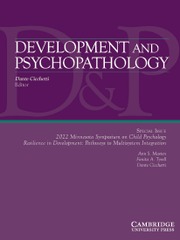No CrossRef data available.
Article contents
Structure of internalizing and externalizing symptoms in early adolescence: A comparison of a bifactor and a two-factor model over time and across reporters
Published online by Cambridge University Press: 10 February 2025
Abstract
Psychopathology assessed across the lifespan often can be summarized with a few broad dimensions: internalizing, externalizing, and psychosis/thought disorder. Extensive overlap between internalizing and externalizing symptoms has garnered interest in bifactor models comprised of a general co-occurring factor and specific internalizing and externalizing factors. We focus on internalizing and externalizing symptoms and compare a bifactor model to a correlated two-factor model of psychopathology at three timepoints in a large adolescent community sample (N = 387; 55 % female; 83% Caucasian; M age = 12.1 at wave 1) using self- and parent-reports. Each model was tested within each time-point with 25–28 validators. The bifactor models demonstrated better fit to the data. Child report had stronger invariance across time. Parent report had stronger reliability over time. Cross-informant correlations between the factors at each wave indicated that the bifactor model had slightly poorer convergent validity but stronger discriminant validity than the two-factor model. With notable exceptions, this pattern of results replicated across informants and waves. The overlap between internalizing and externalizing pathology is systematically and, sometimes, non-linearly related to risk factors and maladaptive outcomes. Strengths and weaknesses to modeling psychopathology as two or three factors and clinical and developmental design implications are discussed.
- Type
- Regular Article
- Information
- Copyright
- © The Author(s), 2025. Published by Cambridge University Press



